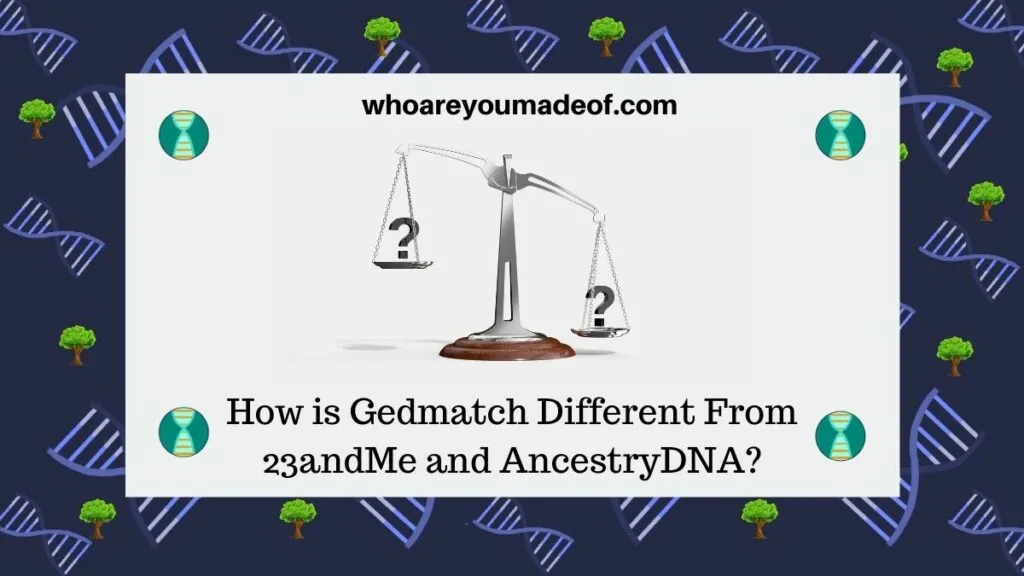If you are new to DNA testing, you might have heard of Gedmatch. In this post, exactly how and why Gedmatch is different from sites like AncestryDNA and 23andMe.

Gedmatch is a very interesting website with several powerful DNA analysis tools. The first time that I used it, I couldn’t believe my eyes – such technology available at our fingertips!
Those of us who have done a DNA test with AncestryDNA, 23andMe, or any of the other major DNA testing sites, have access to an incredible level of technology through the tools available on Gedmatch. In addition, most of the features on Gedmatch are available for free.
It feels like I am getting a bit ahead of myself. Let’s get started learning about why Gedmatch isn’t like the other sites you can use for learning about your DNA.
What is the main difference between Gedmatch and other DNA sites?
The main difference between Gedmatch and other DNA sites, such as 23andMe and AncestryDNA, is that Gedmatch does not actually test your DNA. Instead, you can upload your DNA data from those other sites in order to access the DNA analysis tools available on Gedmatch.
To put it another way, you can use your DNA results from your test that you did with several other companies to learn more about your DNA, family tree, and genetic relatives, on Gedmatch. AncestryDNA and 23andMe are DNA testing companies that collect and analyze your DNA and have their own interactive dashboards that they provide to help you understand and learn from your DNA.
When you upload your DNA data to Gedmatch, you get access to different tools and results than you would on your DNA testing site. On Gedmatch, you can:
- Use the One-to-Many comparison tool to find new DNA matches that didn’t test at the same company that you did
- Use the Chromosome Browser to compare your DNA to your DNA matches on the site to view detailed information about size and location on your chromosomes of shared DNA segments
- Use the Admixture (Heritage) tool to get a different ethnicity estimate to see where your ancient ancestors may have lived
- Find people who might be related to you on the same line of your family tree by using the People Who Match Both or 1 of 2 Kits tool
- Discover whether your DNA matches ancient DNA samples by exploring the Archaic DNA Matches Tool
There are several other free tools in addition to those that I mentioned above. Furthermore, there is a paid subscription to Gedmatch, called “Tier 1“, that you can access in order to use more advanced tools such as:
- Expanded versions of the One-to-Many Tool to find thousands of new DNA matches
- Phasing of your DNA matches in order to create new “kits” with only the DNA that you inherited from your mother or father, which helps in identifying paternal vs. maternal DNA matches on Gedmatch
- Matching Segment Search, which can assist you in finding segments shared in common with groups of matches
There are several more technical tools in the Tier 1 dashboard – too many to discuss right here. All you need to know is that there is a lot more that you can learn that what I could possibly list in this article.
Why is Gedmatch different than DNA results from other sites?
Gedmatch was founded by Curtis Rogers and John Olsen in 2010 in order to assist genealogists and those who are interested in DNA research learn more about their family trees. Even though the site has since been acquired by Verogen, a company that focuses on forensic science, Gedmatch has stayed true to its original mission of providing free tools for family tree researchers.
There are currently more than one million users of Gedmatch who initially tested their DNA with a variety of different DNA testing companies. This enables those who upload their DNA to the site to find DNA matches that have tested their DNA with sites that they did not use.
Usually, we can only find DNA matches on the sites of companies that we use to test our DNA. Only a few DNA testing companies accept uploads from other companies.
Gedmatch solves this problem by matching us with people who tested with other companies and uploaded their DNA to their site.
Is Gedmatch more accurate than 23andMe or Ancestry?
Gedmatch is not more or less accurate than 23andMe or Ancestry. It is simply different than those other websites because it does not perform DNA tests.
Instead, Gedmatch uses data from the DNA test that you took with AncestryDNA or 23andMe, or any of the other companies that allow you to download your DNA testing file, to allow you to match your DNA with other Gedmatch users or use the other analysis tools that I mentioned towards the beginning of this article.
When it comes to your Ethnicity Estimate (AncestryDNA) or Ancestry Composition Report (23andMe), these are more accurate when it comes to researching your recent ancestry than the Gedmatch Admixture calculators. This is because 23andMe and AncestryDNA have spent considerable resources into developing very large databases of DNA samples for making the reference panels used to tell you which regions of the world most closely match your DNA, and the results speak for themselves.
Conclusion
I hope that this post has helped you understand the major differences between Gedmatch and websites such as 23andMe, AncestryDNA, and even MyHeritage and Family Tree DNA. It is really quite different!
If you have any questions about something that you read in this post, or if you would like to share your own experience learning something on Gedmatch that you could not have discovered on your DNA testing site, I would love to hear from you in the discussion below.
Thanks for reading today!

